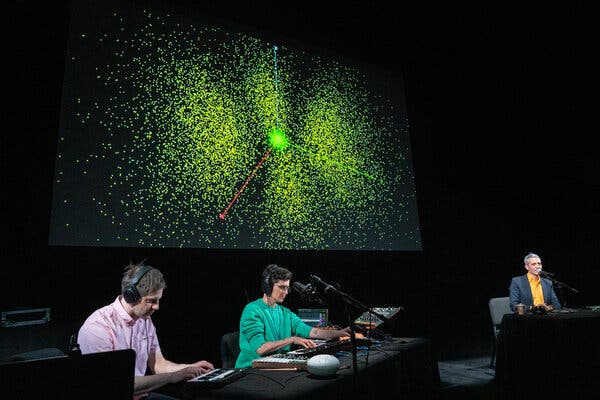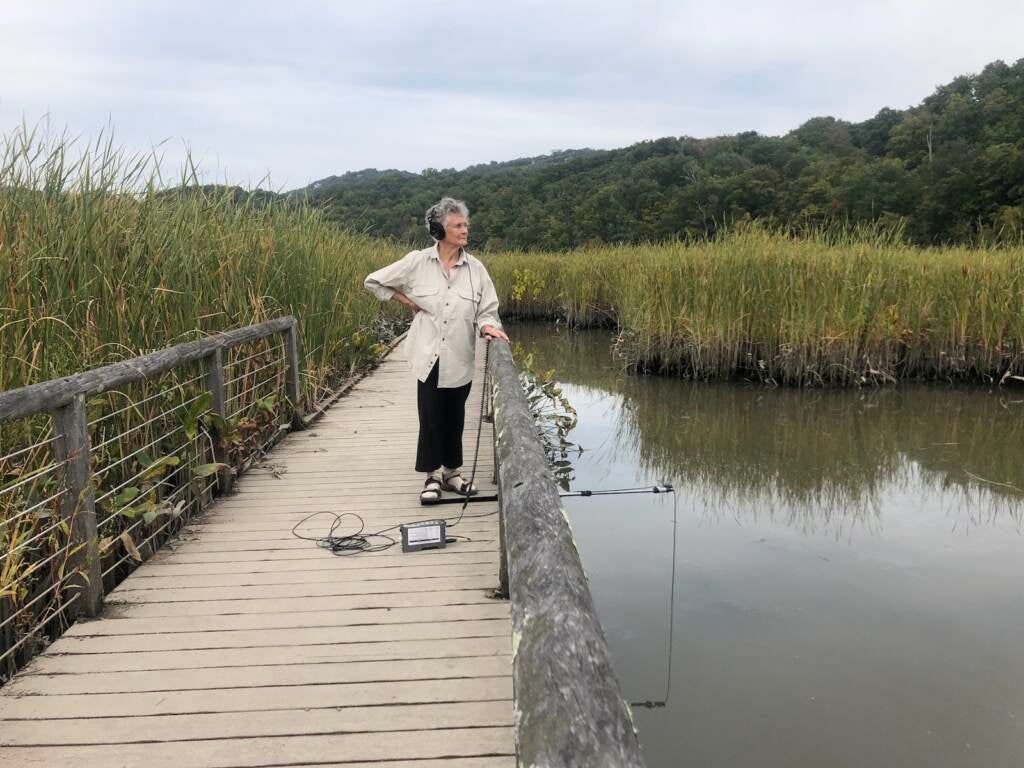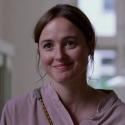Sam Green’s film 32 Sounds has been described as the greatest documentary you’ve ever heard, which is a pretty noisy claim – how does anyone know all the documentaries you’ve experienced? What is certainly true is that the way Green presents his films as immersive events, where musicians play the soundtrack live, the audience wear headphones and the director narrates, makes for a very unusual cinema experience.
32 Sounds, a film that’s both playful and meditative, explores what sound does to our emotional state and reflects on how the invention of recording devices made it possible to hear the voices of the dead. It’s been a big hit at Film Forum in Manhattan, where it played for seven weeks, and has been performed to sell-out crowds in its live iteration (pictured below) with the musician JD Samson (of Le Tigre fame) around the US during 2023. Now it’s coming to London for two special screenings at the Garden Cinema next week, with the hope that it’ll get a longer run in the new year.
 "There’s a listening culture and appreciation of recorded sound in the UK," Green says. "I got started on the project when I read about the British Library’s sound archive, and the first shoot we did was there – it’s such a cool place and nothing like it exists in the US. I was so knocked out that the BL has a curator of natural sounds and a curator of accents and dialect. It's such a profound way of thinking. And there’s the whole experimental music scene that’s very important in the UK. I’m very happy to be there as the descendant of all those trajectories in a way."
"There’s a listening culture and appreciation of recorded sound in the UK," Green says. "I got started on the project when I read about the British Library’s sound archive, and the first shoot we did was there – it’s such a cool place and nothing like it exists in the US. I was so knocked out that the BL has a curator of natural sounds and a curator of accents and dialect. It's such a profound way of thinking. And there’s the whole experimental music scene that’s very important in the UK. I’m very happy to be there as the descendant of all those trajectories in a way."
Green started out making documentaries in a fairly conventional way. The Weather Underground, his 2002 film about the American Marxist militants, was Oscar-nominated. But it was when he was struggling with an early cut of another documentary that he stumbled across the concept of staging live immersive screenings:
"I made this experimental documentary about utopia. It was four different stories that were all about utopias but they were all totally unrelated. I made a rough cut of it and I thought, 'This is like a poem about utopia, all the stories resonate with each other and people will find the larger meaning.' And then I showed it to people and they were like, 'This makes no sense whatsoever!'
"They didn’t get it and I was totally flummoxed. Then someone asked me to give a talk about the subject, so I showed some clips and talked about what I’m doing and I realised that worked – I communicated the film. I did it a couple of times more and then I did it with live music.
"It was around the time when people started to watch films on their computers under really terrible conditions," Green continues. "I do it, too. I'll watch something on my computer and then I’ll check my email or a text – it’s such a bad way to watch something! And so I thought this form, which is ephemeral, where you really have to be there and turn your phone off, yes, this is the answer!’
"It’s so big, it’s almost operatic and the tools are so powerful – big sound, big music! I did something about Buckminster Fuller with the band Yo La Tengo, who a lot of people love. And when they came out to play, you could feel the audience really thrilling to them. If you had just watched that movie at home with a recorded soundtrack by Yo La Tengo, you might think, 'That’s cool', but seeing them live infuses the situation with energy and electricity.
"I thought, 'There’s so many great ways to use this form', and I’ve kept using it because I’m intrigued by it. It’s fun, too. I get very nervous doing the live shows, I get very scared, but that’s part of it."
 32 Sounds is an assemblage of charming, quirky scenes that engage the audience – whether watching a live screening with headphones or the recorded version. The audience is encouraged to get up and dance to Ennio Morricone and Donna Summer’s disco classic "I Feel Love". The BL curator of natural sounds Cheryl Tips plays us the mating song of a now extinct Hawaiian bird. Experimental music pioneer Annea Lockwood (pictured above) shares her recordings made over fifty years of the underwater sounds of a river and her late girlfriend’s laughter on long distance phone calls. We watch Joanna Fang, a Foley artist, conjure up the audio of a huge, felled pine tree crashing in a snowy forest by drumming her feet on boards and tugging ropes in a recording studio.
32 Sounds is an assemblage of charming, quirky scenes that engage the audience – whether watching a live screening with headphones or the recorded version. The audience is encouraged to get up and dance to Ennio Morricone and Donna Summer’s disco classic "I Feel Love". The BL curator of natural sounds Cheryl Tips plays us the mating song of a now extinct Hawaiian bird. Experimental music pioneer Annea Lockwood (pictured above) shares her recordings made over fifty years of the underwater sounds of a river and her late girlfriend’s laughter on long distance phone calls. We watch Joanna Fang, a Foley artist, conjure up the audio of a huge, felled pine tree crashing in a snowy forest by drumming her feet on boards and tugging ropes in a recording studio.
The artist Christine Sun King, who was born profoundly deaf, demonstrates how she deploys drawings, video, performance, and sign language to convey how deaf people feel about sound. We listen to the rhythmic thrum audible to a baby in the womb, the first sound we ever hear, and a voice-mail message from Green’s late father asking his son to let him know if he wants to be buried in the family plot.
"I always love it when people laugh at the recording of my dad talking from beyond the grave about graves. He was such a Spock-like, no-nonsense person who would always want to do the right thing. When I started this film, it could contain anything. If you make a documentary about Winston Churchill, you know the outlines, the chronology. There’s some options around the edges but it’s constrained. But making a documentary about recorded sound was a completely open subject and there were no obvious contours. At first, it was just what tickled my fancy. There are certain things I love, and some things for unarticulated reasons just resonated with me.
"There's a corny way of talking about art that I’ve never trafficked in, where the sculptor says, 'The sculpture just came out of the rock. I just hit the rock and it emerged itself”. I was always really sceptical about that, so it’s really funny that I’m saying my film came out of the material, but you have a bunch of elements and as you work themes do emerge. In a way the film informs you about what it’s about as much as you shape it. And that really happened when I started to work on it. The film is about time and time passing, memory and loss and the ephemeral nature of sound and how we navigate the past."
Green’s next project, a long-nurtured documentary about trees, may well bring him back to UK. He’s an admirer of the nature writers Roger Deakin and Robert Macfarlane. He is intrigued, too, by the national emotional attachment to historic trees, as witnessed in the recent uproar around the felling of the sycamore at Hadrian’s Wall. In the meantime, try and catch one of the screenings of 32 Sounds in London.














Add comment